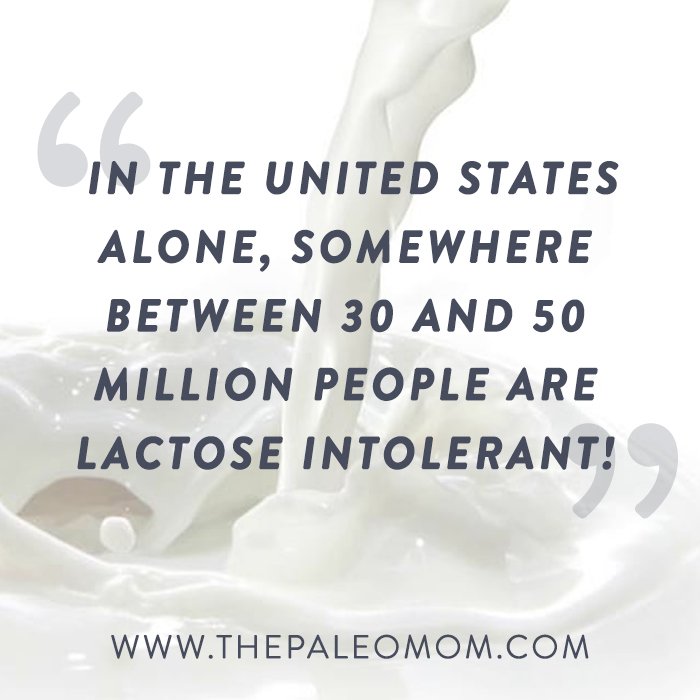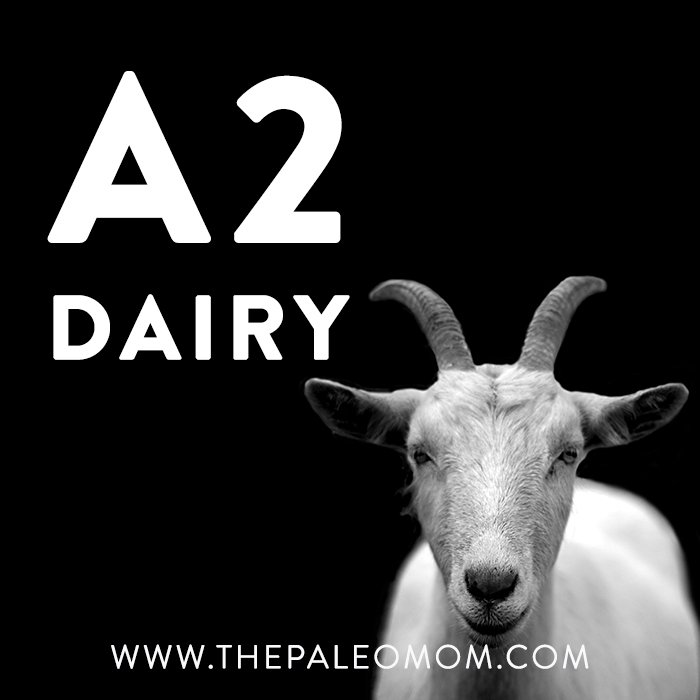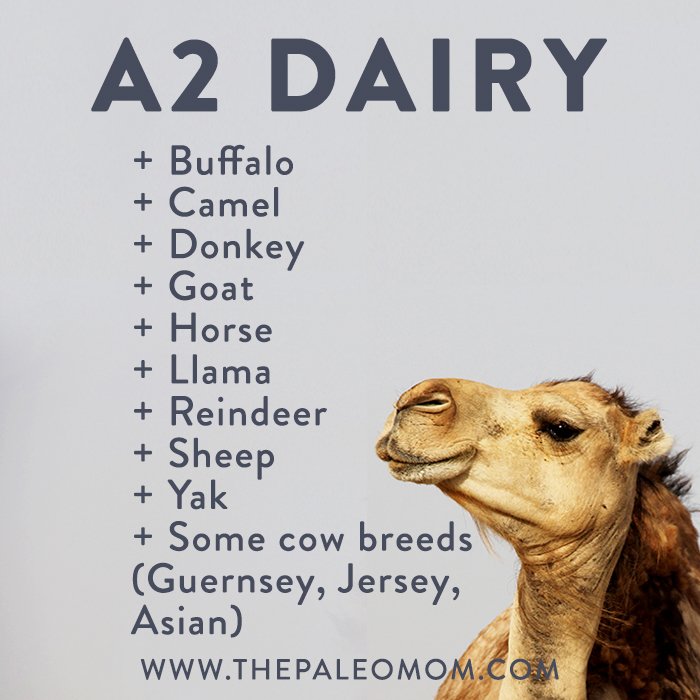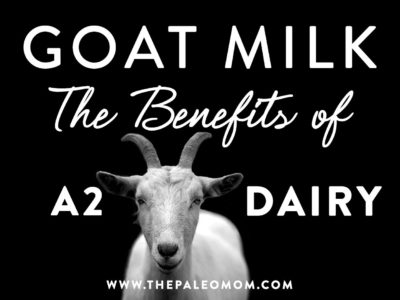
Dairy doesn’t earn a tacit endorsement within the Paleo community. Besides the issues described in The Great Dairy Debate, allergy and intolerance rates are very high. Rates of lactose intolerance (the inability to fully digest lactose, the main sugar in milk) vary widely based on ethnicity, ranging from 5 percent among northern Europeans to over 90 percent in some Asian and African populations. In fact, in the United States alone, somewhere between 30 and 50 million people are lactose intolerant! While lactose intolerance involves a reaction to milk sugar, a true dairy allergy involves reactions to various proteins in milk (including casein and whey). Epidemiological reports of cow’s milk allergies (IgE antibody reactions to cow’s milk proteins) range from between 1 and 17.5 percent in preschoolers, 1 and 13.5 percent in children ages 5 to 16 years, and 1 to 4 percent in adults in Western Countries. The prevalence of cow’s milk sensitivities (IgA and IgG antibody reactions to cow’s milk proteins) is unknown, although one study of IBS patients showed that a whopping 84 percent of participants tested positive for IgG antibodies against milk proteins. That’s an excellent rationale for eliminating dairy and then carefully reintroducing it to see how your body reacts.
For those who tolerate dairy though, there are some compelling reasons to include it in your diet. Studies have shown that consuming dairy, especially full-fat and fermented dairy products, can protect against metabolic syndrome, type 2 diabetes (fermented dairy only), and cardiovascular disease. In fact, one meta-analysis of 31 prospective cohort studies found that dairy consumption in general was associated with a 9 percent lower risk of stroke; calcium from dairy foods was associated with a 31 percent lower risk of stroke; and consumption of cheese was associated with an 18 percent lower risk of coronary heart disease and a 13 percent lower risk of stroke.
Grass-fed dairy is an excellent source of fat-soluble vitamins and conjugated linoleic acid (CLA), an anti-inflammatory fat that can potentially improve body composition and reduce cancer risk. Additional nutrients in dairy can be health-protective in a number of ways, such as calcium reducing vascular resistance and blood pressure; vitamin D improving insulin sensitivity and reducing cancer risk; and potassium, magnesium, and phosphorus playing a role in blood pressure management.
 CLA is a very special family of naturally-occurring trans fats that we can only get from meat and dairy products from ruminants such as beef, lamb and goat. That’s because CLA is created from linoleic acid (an omega-6 fat found in most plant foods) by the bacteria in the stomachs of these herbivorous animals. CLA performs diverse actions in the human body, reducing risk of obesity, cancer, cardiovascular disease, diabetes, and osteoporosis.
CLA is a very special family of naturally-occurring trans fats that we can only get from meat and dairy products from ruminants such as beef, lamb and goat. That’s because CLA is created from linoleic acid (an omega-6 fat found in most plant foods) by the bacteria in the stomachs of these herbivorous animals. CLA performs diverse actions in the human body, reducing risk of obesity, cancer, cardiovascular disease, diabetes, and osteoporosis.
Specifically, CLA
- improves body composition through increased fat metabolism, decreased fat storage, stimulating death of fat cells (adipocyte apoptosis), increased muscle mass and decrease leptin (see page 000).
- blocks the growth and metastatic spread of tumors via effects on arachidonic acid metabolism (impacting prostaglandin, thromboxane and leukotriene formation; see page 000) and modulation of apoptosis (programmed cell death) and cell cycle control.
- prevents atherosclerosis by activating a group of proteins called PPARs that regulate genes involved in lipid metabolism, carbohydrate metabolism, vascular health and inflammation.
- prevents diabetes through improvements in body composition and PPARs’ actions on carbohydrate and lipid metabolism
- improves bone formation by enhances absorption of dietary calcium and by stimulating differentiation (maturation) of bone-forming cells called osteoblasts
- reduce inflammation by reducing expression of pro-inflammatory cytokines like TNF-α and IL-1β while increasing levels of the anti-inflammatory cytokine IL-10
With CLA having so many beneficial effects, you might think to run to the supplement store. Once again, dietary sources win out over capsules—overdoing CLA by loading up on supplements may have some negative effects, such as fatty liver and spleen, colon carcinogenesis and hyperproinsulinemia (where insulin is not sufficiently processed before secretion from the pancreas). Dietary sources of CLA include the fat from grass-fed ruminants and grass-fed dairy.

But, with allergy and intolerance rates so high though, how can we confidently take advantage of the health benefits that grass-fed dairy can provide?
The answer may be A2 Dairy.
The second most abundant protein in milk is β-casein, and there are at least 12 different variants of this one protein. The two most common variants are called A1 and A2 β-casein and it turns out that even though these proteins are extremely similar, they have quite different effects on human health.
Nutrivore Weekly Serving Matrix
An easy-to-use and flexible weekly checklist
to help you maximize nutrient-density.
The Weekly Serving Matrix is very helpful! I’ve been eating along these lines but this really helps me know where to focus vs. which foods serve a more secondary role. It’s super helpful and has taken a lot of worry out of my meal planning. Thanks!
Jan
A1 β-casein is linked to atherosclerosis and ischemic heart disease (heart disease caused by blood clots), and there is evidence that it triggers type 1 diabetes. It causes gastrointestinal inflammation including activating Th2 cells which drive antibody formation (of particular concern for those with autoimmune diseases) and causing histamine release plus it delays gut transit time. A1 β-casein can cause symptoms resembling lactose intolerance (in one study A2 milk didn’t cause symptoms in people who thought they were lactose intolerant) and there’s even evidence that it causes decreased cognitive processing speed and accuracy (i.e., brain fog) in some people. These effects are largely attributable to a peptide product of the digestion of A1 β-casein called β-casomorphin-7. (This is analogous to many of the effects of gluten being attributable to specific gliadin peptides.)
A2 β-casein doesn’t have these effects, however, probably because it doesn’t break down into β-casomorphin-7 in our digestive tract. It’s quite possible that many, if not all, of the potential problems with dairy consumption only apply to A1 dairy, although more research is definitely needed.
Most milk contains a mixture of A1 and A1 β-casein, and the proportion between these two protein variants varies by animal type, breed, herd, state or province, and even country. Most dairy in the USA is from Holstein cows and their milk contains mostly A1 β-casein. In contrast, the following animals produce milk that contains either mostly or completely A2 β-casein (meaning their milk can be labeled as A2 dairy):
 Buffalo
Buffalo- Camel
- Donkey
- Goat
- Horse
- Llama
- Reindeer
- Sheep
- Yak
- Some cow breeds (Guernsey, Jersey, Asian)
Human milk is also predominantly A2 β-casein, although it can contain more A1 β-casein if the mother’s diet is high in A1 dairy. Because of the variability in proportion of A1 and A2 β-casein variants even within the same breed of cow, animals should be genetically tested to verify that their milk only contains A2 β-casein before it is labeled as such.

Grass-fed A2 dairy is a great option for anyone with intolerance or allergy to A1 β-casein (some people are sensitive to both A1 and A2 β-casein). And for those without any dairy intolerance, grass-fed A2 dairy maximizes potential health benefits while minimizing potential health detriments from dairy inclusion in your diet.
My favorite source of grass-fed A2 dairy is Mt. Capra goat milk products. They carry a variety of protein powders (check the ingredients!), ghee and even powdered milk and cream all made from grass-fed goat dairy. Right now, you can save 17.5% on a bundle of my three favorite products.
Citations
Benjamin S and Spener F. Conjugated linoleic acids as functional food: an insight into their health benefits. Nutrition and Metabolism 6 (2009): 36. doi: 10.1186/1743-7075-6-36.
Chia JSJ, McRae JL, et al. A1 beta-casein milk protein and other environmental pre-disposing factors for type 1 diabetes. Nutr Diabetes. 2017 May 15;7(5):e274. doi: 10.1038/nutd.2017.16.
Clemens RA. Milk A1 and A2 peptides and diabetes. Nestle Nutr Workshop Ser Pediatr Program. 2011;67:187-95. doi: 10.1159/000325584. Epub 2011 Feb 16.
Lin H, Wang J, et al. Conjugated linoleic acid prevents age-induced bone loss in mice by regulating both osteoblastogenesis and adipogenesis. Biochemical and Biophysical Research Communications 490, no. 3 (2017): 813-820. doi: 10.1016/j.bbrc.2017.06.122.
Kim H, Kim Y, et al. Conjugated Linoleic Acid: Potential Health Benefits as a Functional Food Ingredient. Annual Review of Food Science and Technology 7 (2016): 221-44. doi: 10.1146/annurev-food-041715-033028.
Jianqin S, Leiming X, et al. Effects of milk containing only A2 beta casein versus milk containing both A1 and A2 beta casein proteins on gastrointestinal physiology, symptoms of discomfort, and cognitive behavior of people with self-reported intolerance to traditional cows’ milk. Nutr J. 2016 Apr 2;15:35. doi: 10.1186/s12937-016-0147-z.
Koronowicz AA, Banks P, et al. Fatty acid extract from CLA-enriched egg yolks can mediate transcriptome reprogramming of MCF-7 cancer cells to prevent their growth and proliferation. Genes and Nutrition 11 (2016): 22. doi: 10.1186/s12263-016-0537-z.
Kurek M, Przybilla B, et al. A naturally occurring opioid peptide from cow’s milk, beta-casomorphine-7, is a direct histamine releaser in man. Int Arch Allergy Immunol. 1992;97(2):115-20.
Laugesen M, and Elliott R. Ischaemic heart disease, Type 1 diabetes, and cow milk A1 beta-casein. N Z Med J. 2003 Jan 24;116(1168):U295.
Shan J, et al, Trypsin impaired epithelial barrier function and induced IL-8 secretion through basolateral PAR-2: a lesson from a stratified squamous epithelial model. American Journal of Physiology – Gastrointestinal and Liver Physiology Published 15 November 2012 Vol. 303 no. 10, G1105-G1112 DOI: 10.1152/ajpgi.00220.2012
Sodhi M, Mukesh M, et al. Milk proteins and human health: A1/A2 milk hypothesis. Indian J Endocrinol Metab. 2012 Sep;16(5):856. doi: 10.4103/2230-8210.100685.
Tailford KA, Berry CL, et al. A casein variant in cow’s milk is atherogenic. Atherosclerosis. 2003 Sep;170(1):13-9.
Ul Haq MR, Kapila , et al. Comparative evaluation of cow β-casein variants (A1/A2) consumption on Th2-mediated inflammatory response in mouse gut. Eur J Nutr. 2014 Jun;53(4):1039-49. doi: 10.1007/s00394-013-0606-7. Epub 2013 Oct 29.











